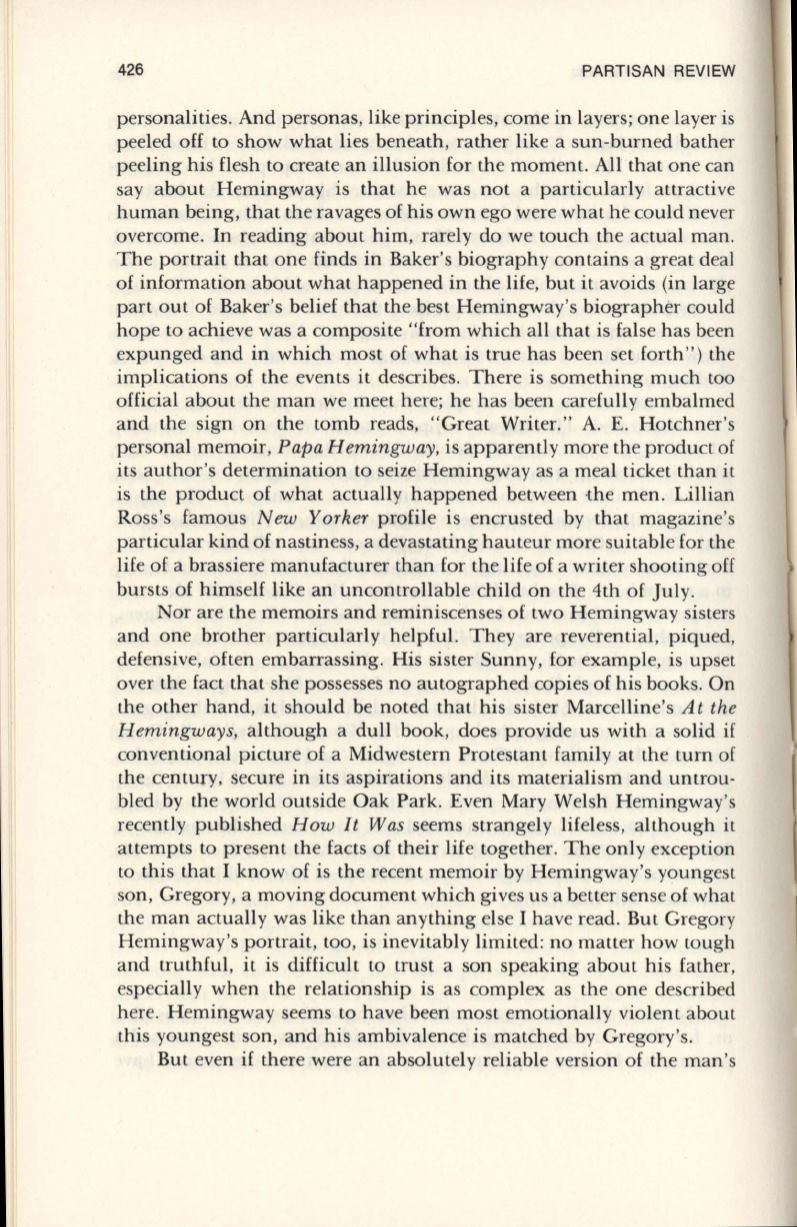
426
PARTISAN REVIEW
personalities. And personas, like principles, come in layers; one layer is
peeled off to show what lies beneath, rather like a sun-burned bather
peeling his flesh to create an illusion for the moment. All that one can
say about Hemingway is that he was not a particularly attractive
human being, that the ravages of his own ego were what he could never
overcome. In reading about him, rarely do we touch the actual man.
The portrait that one finds in Baker's biography contains a great deal
of information about what happened in the life, but it avoids (in large
part out of Baker's belief that the best Hemingway's biographer could
hope to achieve was a composite "from which all that is false has been
expunged and in which most of what is true has been set forth ") the
implications of the events it describes. There is something much too
official about the man we meet here; he has been carefully embalmed
and the sign on the tomb reads, "Great Writer. " A. E. Hotchner's
personal memoir,
Papa Hemingway,
is apparently more the product of
its author's determination to seize Hemingway as a meal ticket than it
is the product of what actually happened between the men . Lillian
Ross 's famous
New Yorker
profile is encrusted by that magazine's
particular kind of nastiness, a devastating hauteur more suitable for the
life of a brassiere manufacturer than for the life of a writer shooting off
bursts of himself like an uncontrollable child on the 4th of July.
Nor are the memoirs and reminiscenses of two Hemingway sisters
and one brother particularly helpful. They are reverential, piqued,
defensive, often embarrassing. His sister Sunny, for example, is upset
over the fact that she possesses no autographed copies of his books. On
the other hand, it should be noted that his sister Marcelline's
A t the
H
emingways,
although a dull book, does provide us with a solid if
conventional picture of a Midwestern Protestant family at the turn of
the century, secure in its aspirations and its materialism and untrou–
bled by the world outside Oak Park. Even Mary Welsh Hemingway's
recently published
How It Was
seems strangely lifeless, although it
attempts to present the facts of their life together. The only exception
to this that I know of is the recent memoir by Hemingway's youngest
son, Gregory, a moving document which gives us a better sense of what
the man actually was like than anything else I have read. But Gregory
Hemingway's portrait, too, is inevitably limited: no matter how tough
and truthful, it is difficult to trust a son speaking about his father,
especially when the relationship is as complex as the one described
here. Hemingway seems to have been most emotionally violent about
this youngest son, and his ambivalence is matched by Gregory 's.
But even if there were an absolutely reliable version of the man 's


